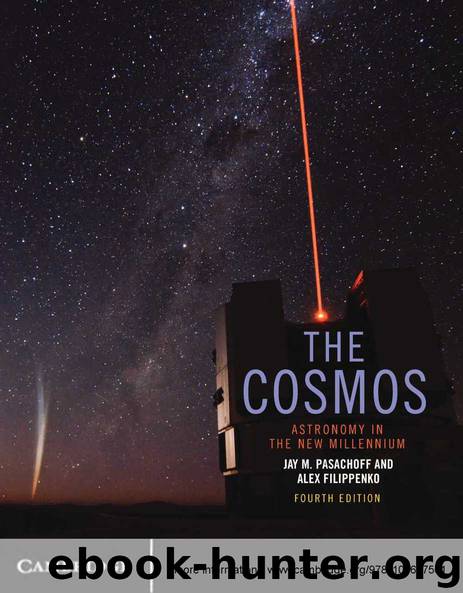The Cosmos by Pasachoff Jay M. & Filippenko Alex

Author:Pasachoff, Jay M. & Filippenko, Alex [Pasachoff, Jay M.]
Language: eng
Format: epub
Publisher: Cambridge University Press
Published: 2013-07-30T22:00:00+00:00
12.3c Radioactivity and Neutrinos
Sometimes an isotope is not stable, in that after a time it will spontaneously change into another isotope or element; we say that such an isotope is radioactive. The most massive elements, those past uranium, are all radioactive, and have average lifetimes that are very short.
It had been theoretically predicted that around element 114, elements should begin being somewhat more stable again. The handful of atoms of elements 114 and 116 discovered in 1998 and 1999 are more stable than those of slightly lower mass numbers – lasting even about 5 seconds instead of a small fraction of a second.
In 2011, element 114 was named florovium (symbol: Fv), after the director of the Russian research institute in Dubna where it and many other elements were discovered, and element 116 was named livermorium (Lv), after the Lawrence Livermore National Laboratory in Livermore, California, also where many of these newer elements were first made. For example, the two teams collaborated in making livermorium by crashing calcium, with 20 protons, into curium, with 96 protons. The livermorium quickly decayed into the element florovium, which they also made directly by crashing calcium into plutonium with its 94 protons. (A claim that element 118 was also discovered has been withdrawn.)
During certain types of radioactive decay, as well as when a free proton and electron combine to form a neutron, a particle called a neutrino is given off. A neutrino is a neutral particle having almost no mass (its name comes from the Italian for “little neutral one”).
Neutrinos have a very useful property for the purpose of astronomy: They rarely interact at all with matter. Thus, when a neutrino is formed deep inside a star, it can usually escape to the outside without interacting with any of the matter in the star. A photon of electromagnetic radiation, on the other hand, can travel only about 0.5 mm (on average) in a stellar interior before it is absorbed, and it takes about a hundred thousand years for a photon to zig and zag its way to the surface.
The elusiveness of the neutrino not only makes it a valuable messenger – indeed, the only possible direct messenger – carrying news of the conditions inside the Sun at the present time, but also makes it very difficult for us to detect on Earth. A careful experiment carried out over several decades found only about 1/3 the expected number of neutrinos, as we shall soon see.
Download
This site does not store any files on its server. We only index and link to content provided by other sites. Please contact the content providers to delete copyright contents if any and email us, we'll remove relevant links or contents immediately.
| Aeronautics & Astronautics | Astronomy |
| Astrophysics & Space Science | Comets, Meteors & Asteroids |
| Cosmology | Mars |
| Solar System | Star-Gazing |
| Telescopes | UFOs |
Tools of Titans by Timothy Ferriss(8213)
Turbulence by E. J. Noyes(7935)
Secrets of Antigravity Propulsion: Tesla, UFOs, and Classified Aerospace Technology by Ph.D. Paul A. Laviolette(5309)
Astrophysics for People in a Hurry by Neil DeGrasse Tyson(5130)
Room 212 by Kate Stewart(5035)
Design of Trajectory Optimization Approach for Space Maneuver Vehicle Skip Entry Problems by Runqi Chai & Al Savvaris & Antonios Tsourdos & Senchun Chai(5011)
Pale Blue Dot by Carl Sagan(4907)
The David Icke Guide to the Global Conspiracy (and how to end it) by David Icke(4624)
A Journey Through Divination and Astronomy by Publishing Pottermore(4340)
Goodbye Paradise(3724)
Apollo 8 by Jeffrey Kluger(3635)
COSMOS by Carl Sagan(3553)
Losing the Nobel Prize by Brian Keating(3498)
The Five People You Meet in Heaven by Mitch Albom(3474)
How to Read Water: Clues and Patterns from Puddles to the Sea (Natural Navigation) by Tristan Gooley(3406)
Brief Answers to the Big Questions by Stephen Hawking(3369)
How to Read Nature by Tristan Gooley(3249)
The Order of Time by Carlo Rovelli(3144)
A Brief History of Time by Stephen Hawking(2959)
